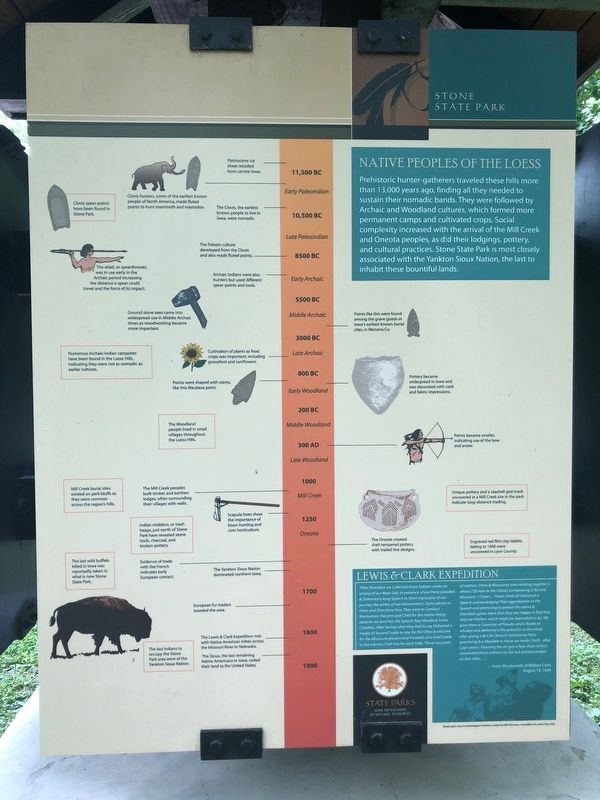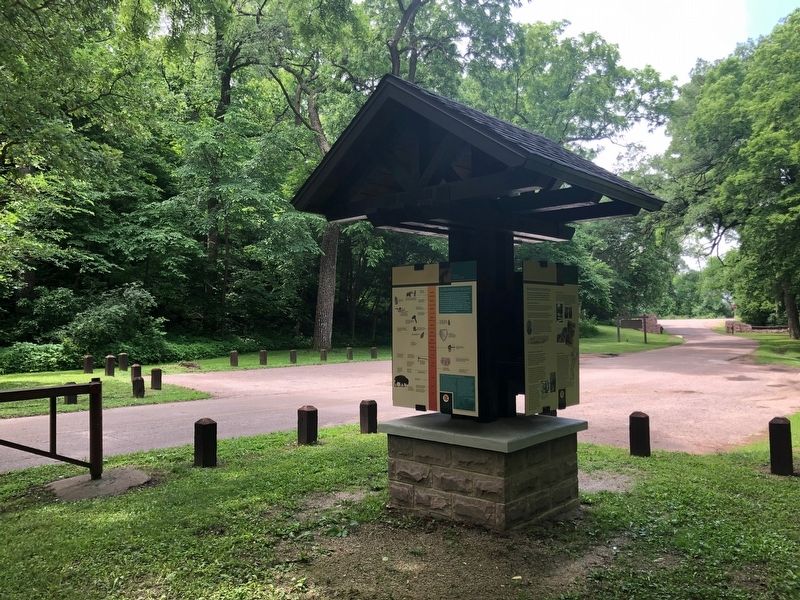Sioux City in Woodbury County, Iowa — The American Midwest (Upper Plains)
Native Peoples of the Loess
Stone State Park
Prehistoric hunter-gatherers traveled these hills more than 13,000 years ago, finding all they needed to sustain their nomadic bands. They were followed by Archaic and Woodland cultures, which formed more permanent camps and cultivated crops. Social complexity increased with the arrival of the Mill Creek and Oneota peoples, as did their lodgings, pottery, and cultural practices. Stone Stare Park is most closely associated with the Yankton Sioux Nation, the last to inhabit these bountiful lands.
Lewis & Clark Expedition
"After Brackfast we Collected those Indians under an orning of our Main Sail, in presence of our Party paraded & Delivered a long Speech to them expressive of our journey the wirkes of our Government, Some advice to them and Directions how They were to Conduct themselves, the principal Chief for the nation being absente we sent him the Speech flag Meadel & Some Cloathes. After hering what they had to say Delivered a medal of Second Grade to one for the Ottos & one for the Missourie present and 4 medals of a third Grade to the inferior Chief two for each tribe. Those two parts of nations. Ottos & Missouries now residing together is about 250 men at the Ottoes Composeing 2/3d and Missourie 1/3 part… Those chiefs all Delivered a Speech acknowledging Their approbation to the Speech and promising to prosue the advice & Directions given them that they wer happy to find that they had fathers which might be depended on &. We gave them a Cannister of Powder and a Bottle of whiskey and delivered a few presents to the whole after giving a Br:Cth: [breech cloth/some Paint quartering & a Meadele to those we made Cheifs after Capt Lewis's Shooting the air gun a feiw shots (which astonished those natives) we Set out and proceeded on five miles…."
- From the journals of William Clark
August 19, 1804
Time Line
Pleistocene ice sheet receded from the central Iowa.
11, 500 BC
Clovis hunters, some of the earliest known people of North America, made fluted points to hunt mammoth and mastodon. Clovis spear-points have been found in Stone Park.
Early Paleoindian
The Clovis, the earliest known people to live in Iowa, were nomadic.
10,500 BC
Late Paleoindian
The Folsom culture developed from the Clovis and also made fluted points.
8500 BC
The Atlatl, or spear thrower, was in use early in the Archaic period increasing the distance a spear could travel and the force of its impact. Archaic Indians were also hunters but used different spear-points and tools.
Early Archaic
5500 BC
Middle Archaic
Ground stone axes came into widespread use in Middle Archaic times as woodworking became more important. Numerous Archaic-Indian campsites have been found in the Loess Hills, indicating they were not as nomadic as earlier cultures. Points like this were found among the grave goods a Iowa's earliest known burial sites in Monona Co.
3000 BC
Late Archaic
Cultivation of plants as food crops was important, including goosefoot and sunflowers.
800 BC
Points were shaped with stems like this Waubesa point. Pottery became widespread in Iowa and was decorated with cord and fabric impressions.
Early Woodland
200 BC
The Woodloand people lived in small villages throughout the Loess Hills.
Middle Woodland
300 AD
Points became smaller, indicating use of the bow and arrow.
Late Woodland
1000
The mill Creek peoples built timber and earthen lodges, often surrounding their villages with walls. Mill Creek burial sites existed on park bluffs as they were common across the region's hills.
Mill Creek
Acapula hoes show the importance of bison hunting and corn horticulture. Indian middens, or trash heaps, just north of Stone Park have revealed stone tools, charcoal, and broken pottery. Unique pottery and a seashell god mask uncovered at a Mill Creek site in the park indicate long-distance trading.
1250 Oneota
The Oneota created shell-tempered pottery with trailed line designs. Engraved red flint clay tablets dating to 1600 were uncovered in Lyon County.
Evidence of trade with the French indicates early European contact. The Yankton Sioux Nation dominated northern Iowa. The last wild buffalo killed in Iowa was reportedly taken to what is now Stone Park.
1700
European fur traders traveled the area.
1800
The Lewis & Clark Expedition met with Native American tribes across the Missouri River in Nebraska. The last Indians to occupy the Stone Park area were of the Yankton Sioux Nation. The Sioux, the last remaining Native Americans in Iowa, ceded their land to the United States.
1900
Erected by State Parks Iowa Department of Natural Resources.
Topics. This historical marker is listed in these topic lists: Anthropology & Archaeology • Native Americans • Parks & Recreational Areas. A significant historical date for this entry is August 19, 1804.
Location. 42° 33.421′ N, 96° 28.509′ W. Marker is in Sioux City, Iowa, in Woodbury County. Marker is on Stone State Park Drive. Located at the western entrance to Stone State Park. Touch for map. Marker is in this post office area: Sioux City IA 51103, United States of America. Touch for directions.
Other nearby markers. At least 8 other markers are within 5 miles of this marker, measured as the crow flies. From Settlement to State Park (a few steps from this marker); Geology Wonders (a few steps from this marker); An American Treasure (approx. 0.2 miles away); Prairies in the Hills (approx. 0.3 miles away); Big Sioux River Valley (approx. 0.3 miles away); You Are Entering South Dakota (approx. 2.2 miles away in South Dakota); Grand Army of the Republic (approx. 4.4 miles away); Twelve Mile House (approx. 5 miles away in South Dakota). Touch for a list and map of all markers in Sioux City.
Credits. This page was last revised on May 20, 2020. It was originally submitted on July 10, 2019, by Ruth VanSteenwyk of Aberdeen, South Dakota. This page has been viewed 381 times since then and 60 times this year. Photos: 1, 2. submitted on July 10, 2019, by Ruth VanSteenwyk of Aberdeen, South Dakota. • Andrew Ruppenstein was the editor who published this page.

